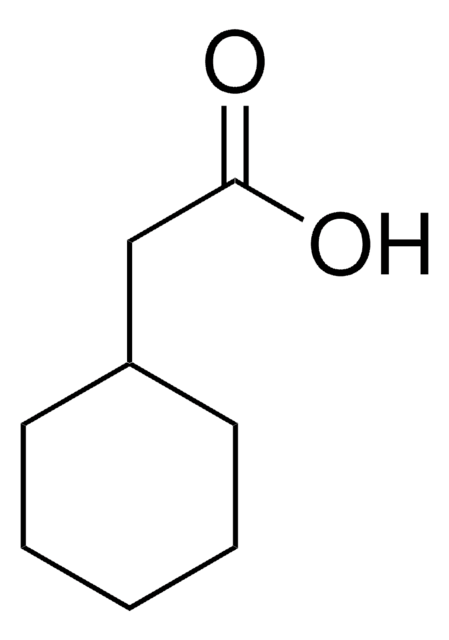101834
Cyclohexanecarboxylic acid
98%
Synonim(y):
Hexahydrobenzoic acid
About This Item
Polecane produkty
Próba
98%
Postać
solid
współczynnik refrakcji
n20/D 1.461 (lit.)
tw
232-233 °C (lit.)
mp
29-31 °C (lit.)
rozpuszczalność
H2O: soluble 0.201g in 100g at 15 °C
organic solvents: soluble
gęstość
1.033 g/mL at 25 °C (lit.)
ciąg SMILES
OC(=O)C1CCCCC1
InChI
1S/C7H12O2/c8-7(9)6-4-2-1-3-5-6/h6H,1-5H2,(H,8,9)
Klucz InChI
NZNMSOFKMUBTKW-UHFFFAOYSA-N
Szukasz podobnych produktów? Odwiedź Przewodnik dotyczący porównywania produktów
Zastosowanie
Działania biochem./fizjol.
Uwaga dotycząca przygotowania
Hasło ostrzegawcze
Warning
Zwroty wskazujące rodzaj zagrożenia
Zwroty wskazujące środki ostrożności
Klasyfikacja zagrożeń
Acute Tox. 4 Oral - Eye Irrit. 2
Kod klasy składowania
11 - Combustible Solids
Klasa zagrożenia wodnego (WGK)
WGK 3
Temperatura zapłonu (°F)
Not applicable
Temperatura zapłonu (°C)
Not applicable
Środki ochrony indywidualnej
dust mask type N95 (US), Eyeshields, Gloves
Certyfikaty analizy (CoA)
Poszukaj Certyfikaty analizy (CoA), wpisując numer partii/serii produktów. Numery serii i partii można znaleźć na etykiecie produktu po słowach „seria” lub „partia”.
Masz już ten produkt?
Dokumenty związane z niedawno zakupionymi produktami zostały zamieszczone w Bibliotece dokumentów.
Klienci oglądali również te produkty
Nasz zespół naukowców ma doświadczenie we wszystkich obszarach badań, w tym w naukach przyrodniczych, materiałoznawstwie, syntezie chemicznej, chromatografii, analityce i wielu innych dziedzinach.
Skontaktuj się z zespołem ds. pomocy technicznej









